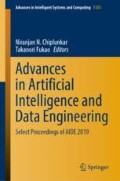Abstract
Handwriting classification and identification is one of the most interesting issues in the current research because of its variety of applications. It has leveraged its potential in reducing the manual work of converting the documents containing handwritten characters to machine-readable texts. The deep convolutional neural networks (DCNNs) are successfully implemented for the recognition of characters in various languages. This paper proposes a DCNN-based architecture for the classification of Tulu language characters. Tulu is one of the five Dravidian groups of languages used by around 50 Lakh people in the states of Karnataka and Kerala. This model is mainly developed to assist the character recognition of Tulu documents. A total of 90,000 characters including both vowels and consonants have been included in the dataset. This architecture is showing a satisfactory test accuracy of 92.41% for the classification of 45 handwritten characters.
Access this chapter
Tax calculation will be finalised at checkout
Purchases are for personal use only
References
Caldwell R (1856) Comparative grammar of dravidian or South Indian family of languages, Trübner & Co., London
Bhat Sachin, Seshikala G (2019) Preprocessing of historical manuscripts using phase congruency Features and gaussian mixture model. Far East J Electron Commu 19(1):47–67
Kingma DP, J Ba (2014) Adam: a method for stochastic optimization. arXiv preprint arXiv:1412.6980
Zhao H, Hu Y, Zhang J (2017) Character recognition via a compact convolutional neural network. In: 2017 International conference on digital image computing: techniques and applications (DICTA). IEEE
de Campos, TE (2012) The Chars74K dataset: character recognition in natural images. University of Surrey. Guildford, Surrey, UK
Lucas SM et al (2003) ICDAR 2003 robust reading competitions. Null. IEEE
He P, Huang W, Qiao Y, Loy CC, Tang X (2016) Detecting oriented text in natural images by linking segments. In: AAAI conference on artificial intelligence (AAAI)
Shi B, Bai X, Yao C (2016) An end-to-end trainable neural network for image-based sequence recognition and its application to scene text recognition. IEEE Trans Pattern Anal Mach Intell
Mhiri M, Desrosiers C, Cheriet M (2018) Convolutional pyramid of bidirectional character sequences for the recognition of handwritten words. Pattern Recogn Lett 111:87–93
Marti U-V, Bunke Horst (2002) The IAM-database: an english sentence database for offline handwriting recognition. Int J Doc Anal Recogn 5(1):39–46
Biswas Mithun et al (2017) Banglalekha-isolated: a multi-purpose comprehensive dataset of handwritten Bangla isolated characters. Data in brief 12:103–107
Sarkar R, Das N, Basu S, Kundu M, Nasipuri M, Basu DK (2012) Cmaterdb1: a database of unconstrained handwritten Bangla and Bangla—English mixed script document image. Int J Doc Anal Recognit (IJDAR) 15(1):71–83
Rabby ASA et al (2018) BornoNet: bangla handwritten characters recognition using convolutional neural network. Procedia Comput Sci 143:528–535
Alom MZ et al (2017) Handwritten bangla digit recognition using deep learning. arXiv preprint arXiv:1705.02680
Larsson G, Maire M, Shakhnarovich G (2016) Fractalnet: ultra-deep neural networks without residuals. arXiv preprint arXiv:1605.07648
He K et al (2016) Deep residual learning for image recognition. In: Proceedings of the IEEE conference on computer vision and pattern recognition
Sachin B, Seshikala G (2018) Preprocessing and binarization of inscription images using phase based features. In: 2018 Second international conference on advances in electronics, computers and communications (ICAECC). IEEE
Krizhevsky A, Sutskever I, Hinton GE (2016) Imagenet classification with deep convolutional neural networks. In: Advances in neural information processing systems, pp 1097–1105; Huang G et al (2012) Densely connected convolutional networks. arXiv preprint arXiv:1608.06993
Karki M et al (2018) Pixel-level reconstruction and classification for noisy handwritten bangla characters. arXiv preprint arXiv:1806.08037
Prakash KC et al (2018) Optical character recognition (OCR) for Telugu: database, algorithm and application. In: 2018 25th IEEE international conference on image processing (ICIP). IEEE
Avadesh M, Goyal N (2018) Optical character recognition for sanskrit using convolution neural networks. In: 2018 13th IAPR international workshop on document analysis systems (DAS). IEEE
Simonyan K, Zisserman A (2014) Very deep convolutional networks for large-scale image recognition. arXiv preprint arXiv:1409.1556
Agostinelli F et al (2014) Learning activation functions to improve deep neural networks. arXiv preprint arXiv:1412.6830
Srivastava Nitish et al (2014) Dropout: a simple way to prevent neural networks from overfitting. J Mach Learn Res 15(1):1929–1958
Zang F, Zhang J (2011) Softmax discriminant classifier. In: 2011 Third international conference on multimedia information networking and security (MINES). IEEE
Author information
Authors and Affiliations
Corresponding author
Editor information
Editors and Affiliations
Rights and permissions
Copyright information
© 2021 Springer Nature Singapore Pte Ltd.
About this paper
Cite this paper
Bhat, S., Seshikala, G. (2021). Character Recognition of Tulu Script Using Convolutional Neural Network. In: Chiplunkar, N.N., Fukao, T. (eds) Advances in Artificial Intelligence and Data Engineering. AIDE 2019. Advances in Intelligent Systems and Computing, vol 1133. Springer, Singapore. https://doi.org/10.1007/978-981-15-3514-7_11
Download citation
DOI: https://doi.org/10.1007/978-981-15-3514-7_11
Published:
Publisher Name: Springer, Singapore
Print ISBN: 978-981-15-3513-0
Online ISBN: 978-981-15-3514-7
eBook Packages: Intelligent Technologies and RoboticsIntelligent Technologies and Robotics (R0)

